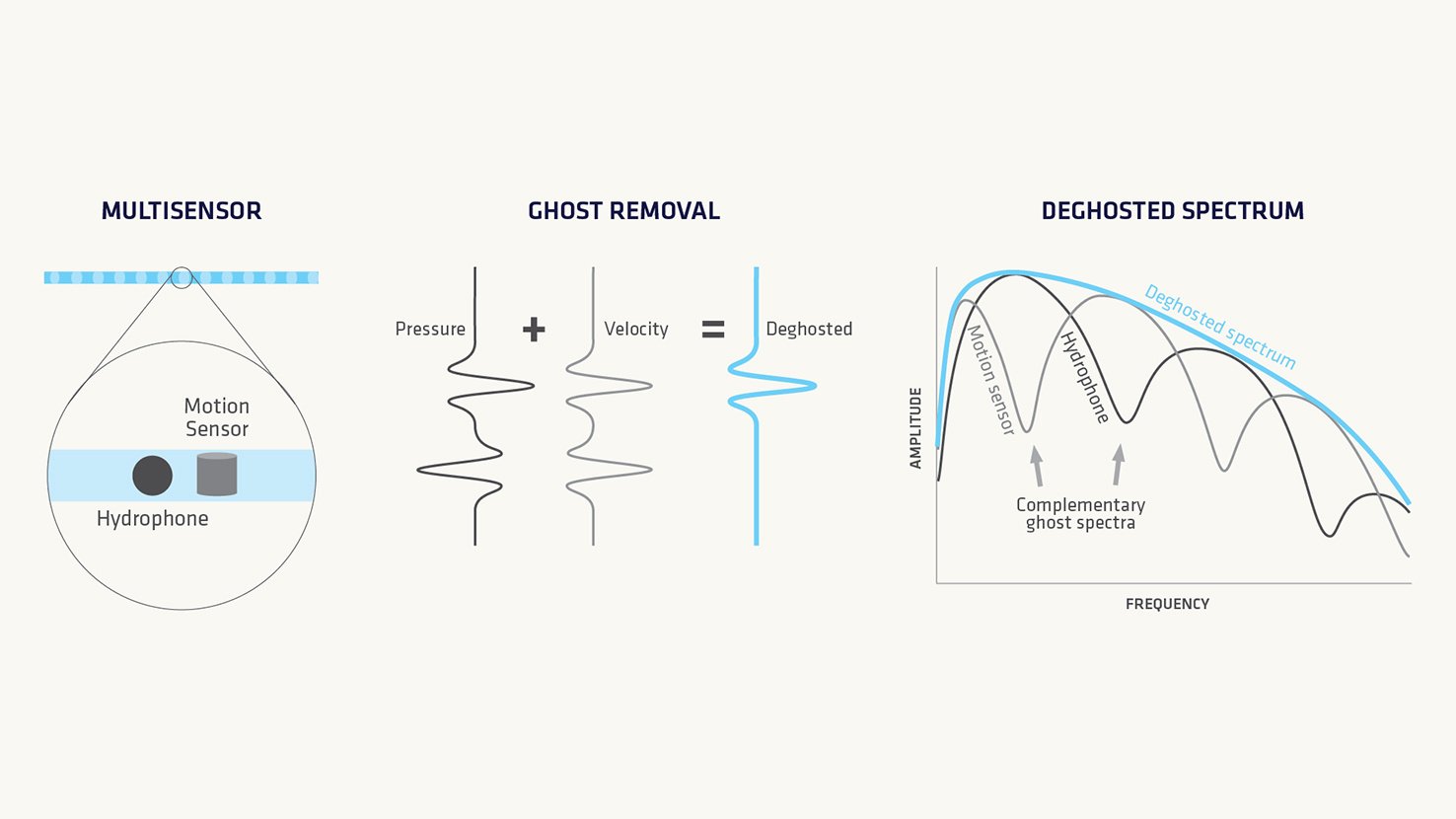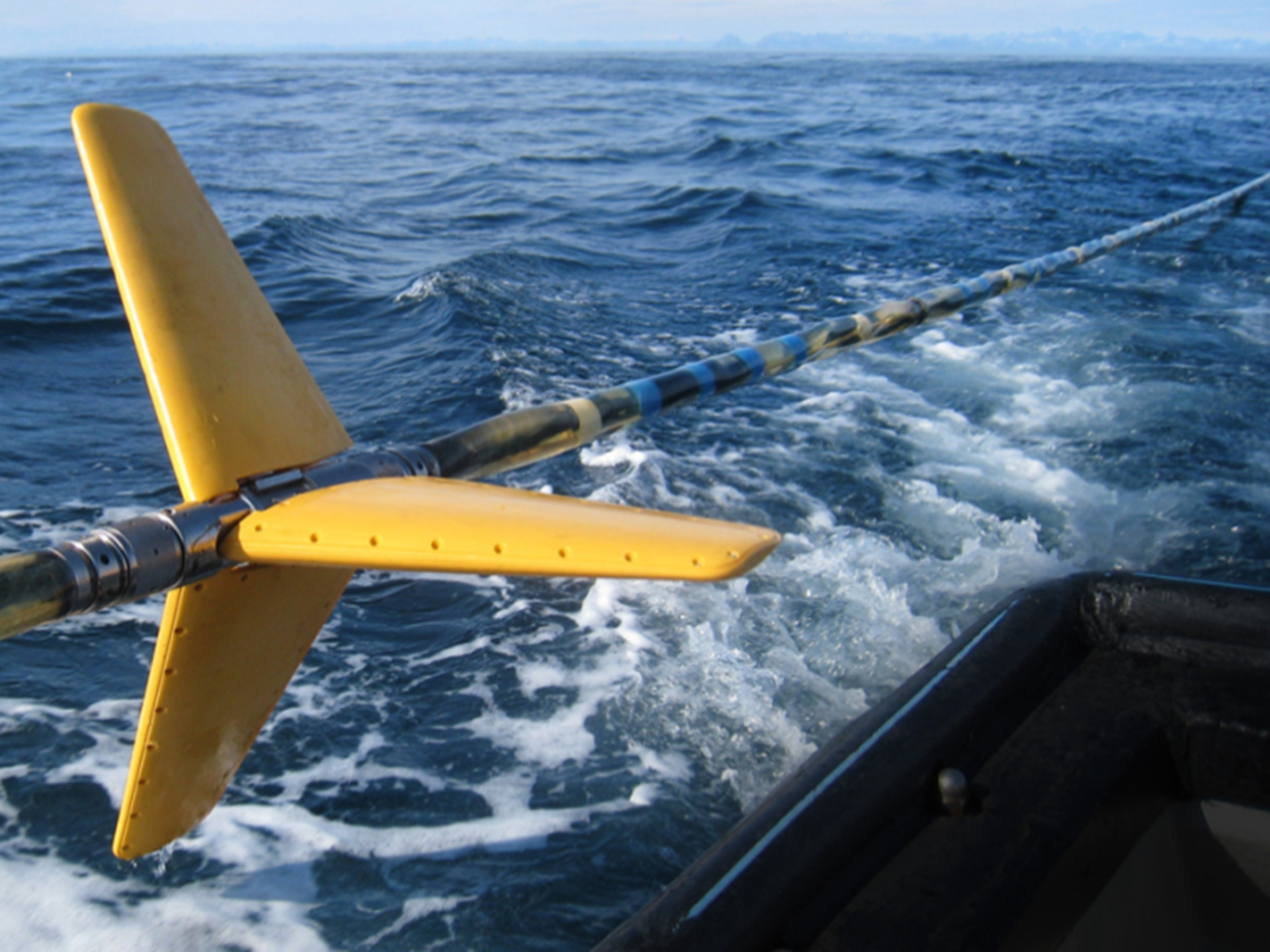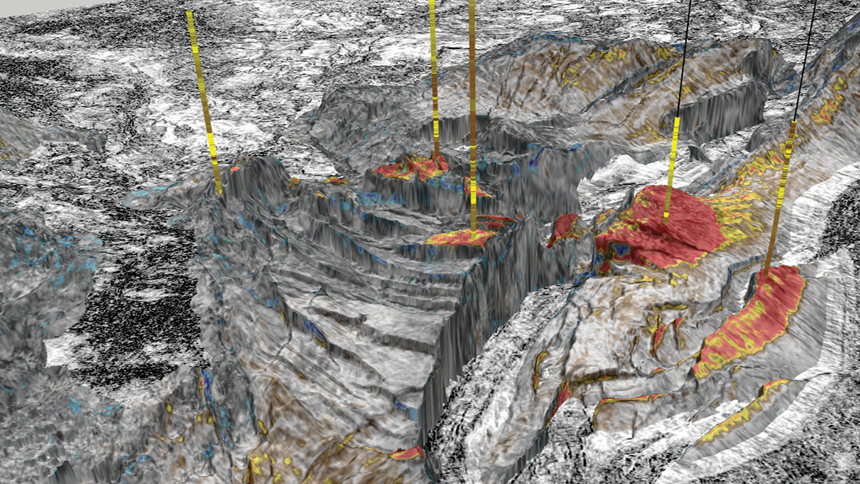GeoStreamer
Accurate Characterization of the Subsurface
Broadband data acquired with GeoStreamer multisensor technology is perfect for high-fidelity reservoir monitoring and imaging at all target depths.
GeoStreamer uses both hydrophones and velocity sensors to remove all free-surface ghost reflections from marine seismic data. The streamer is towed deep, with a low-drag depth profile to minimize exposure to weather and surface noise. Data is rich in both low- and high-frequency signal, and ideal for high-fidelity reservoir monitoring, broadband imaging at all target depths, and the recovery of accurate geological properties during reservoir characterization.
Advantages of GeoStreamer
-
Separate Wavefields
-
Steerable Streamers
Separate Wavefields
Mitigating the Effect of the Receiver Ghost
Collocated groups of hydrophone pressure sensors and vertical velocity sensors record the continuous interference between the wavefield scattered upward from the subsurface geology and the downgoing wavefield that carries the imprint of the reflecting sea surface, which varies with each shot. This downgoing component is known as the ghost wavefield.
Wavefield separation is a critical step in broadband seismic imaging workflows applied to multisensor streamer and node seismic data. The pressure and velocity sensors record each upgoing seismic event with equal polarity, while the time-delayed downgoing event (i.e., the ghost) is recorded with opposite polarity. This polarity difference enables effective separation of the two wavefields.
- Higher-signal-to-noise ratio (SNR) than hydrophone-only streamers for all survey conditions
- Longer operating windows due to low-noise deep towing
- Free of artifacts associated with local variations in sea-surface height or receiver depth
- 4D signals are free of non-repeatable sea-state variations, which means reservoir monitoring can detect heterogeneous reservoir fluid movement and pressure with the highest fidelity and resolution
- Shallow seismic images have substantially fewer artifacts, and shallow geohazards can be detected with far greater confidence and resolution: SWIM
- High-fidelity AVO / AVA pre-stack gathers are optimal for quantitative interpretation and subsurface characterization
- Velocity estimation benefits from deep towing: FWI

All events associated with sea-surface ghost reflections can be isolated and removed to support traditional high-resolution imaging and subsurface characterization. Alternatively, the separated wavefields can be used for SWIM (Seismic While Imaging with Multiples) to enhance resolution in the shallow subsurface, particularly in areas where conventional imaging methods are less effective.
The TGS wavefield separation solution preserves all pre-stack amplitude-versus-angle (AVA) information essential for accurate subsurface characterization. This is achieved by accounting for 3D emergence angle variations along each GeoStreamer.
From an operational standpoint, multisensor streamers are inherently quieter, as they allow for deep towing with a shallower front end. This configuration reduces mechanical tension and enables very wide streamer spreads. Deep towing also delivers a rich low-frequency response in the upgoing wavefield, while the design preserves high-frequency content. The result is a broadband signal that is not affected by sea-surface variations.
Accurately removing the time- and space-varying downgoing wavefield, known as the receiver ghost, improves survey repeatability, which is critical for 4D reservoir monitoring and CCS/CCUS applications.
Steerable Streamers
eBirds Enable Control of Receiver Positions
Tri-wing eBirds, integrated in the GeoStreamer, enable depth and lateral steering control with minimal drag. Safety is improved, positioning is more accurate, and reservoir monitoring is more repeatable.
Streamer fanning can minimize infill during acquisition. Other benefits include improved safety during deployment, retrieval, and in-sea maintenance.
This Kongsberg eBird is specially designed for the GeoStreamer and offers effective lateral steering and depth control of seismic streamers with a minimum of additional acoustic noise. This uniform three-wing solution and the built-in controller also provide full roll control capabilities, with eBirds mounted every 300 m along the streamers. Feather correction achievable is typically two to three degrees.

- Better accuracy with depth and lateral steering control
- Low drag, slim-line system is fully integrated within the GeoStreamer body, minimizing turbulence and guaranteeing low noise even during line turns
- Better control of streamer feathering – typically automated within ± 3 degrees
- Maximum availability of Common Midpoint (CMP) offset-class traces for matching source and receiver positions during reservoir monitoring (4D) data processing
Let’s Discuss Your Acquisition Needs
With the industry’s most diverse fleet and integrated expertise, from survey design and acquisition to seismic data imaging, TGS delivers trusted, tailored solutions for complex exploration challenges.
Learn More About Our Fleet
Discover the capabilities, configurations and proven performance of our diverse fleet. Built for reliability and efficiency, our vessels are ready to meet your exploration needs, anywhere in the world.
Start the Conversation
Every project is different. Talk to a TGS expert about your specific acquisition requirements. With decades of trusted experience and integrated capabilities, we’ll help you design the right solution from the start.



